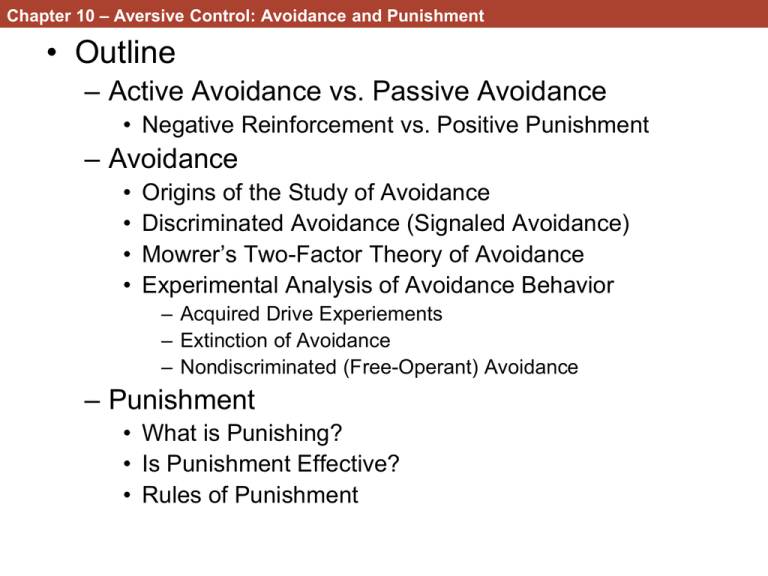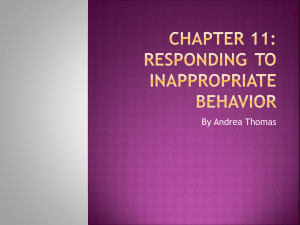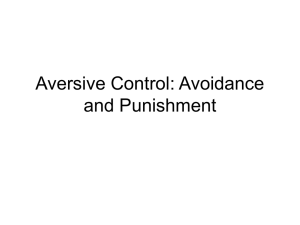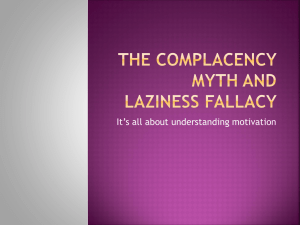Chapter 10: Aversive Control: Avoidance and Punishment
advertisement

Chapter 10 – Aversive Control: Avoidance and Punishment • Outline – Active Avoidance vs. Passive Avoidance • Negative Reinforcement vs. Positive Punishment – Avoidance • • • • Origins of the Study of Avoidance Discriminated Avoidance (Signaled Avoidance) Mowrer’s Two-Factor Theory of Avoidance Experimental Analysis of Avoidance Behavior – Acquired Drive Experiements – Extinction of Avoidance – Nondiscriminated (Free-Operant) Avoidance – Punishment • What is Punishing? • Is Punishment Effective? • Rules of Punishment • Avoidance procedures increase the occurrence of instrumental behavior – Active avoidance • Negative Reinforcement (Escape or Avoidance) – Learn to make a response to avoid a negative outcome • Punishment procedures suppress instrumental responding – Passive avoidance • Positive Punishment – Learn to withhold responding to avoid a negative outcome. • Origins of the study of avoidance – Vladimir Becherev (1913) • Participants were asked to put their finger on a metal plate. – tone (CS) was followed by a shock (US) through the metal plate – Participants quickly learned to pick up their finger (CR) when they heard the tone (CS). • This was considered to be a standard example of classical conditioning. – But it was different • Removing finger cancelled the US – avoidance • Brogden, Lipman, and Culler (1938) – Directly compared classical conditioning to avoidance learning • Guinea pigs in a running wheel. – CS- tone – US – shock • The shock stimulated the guinea pigs to run (UR) • Gp1 • Classical • US always followed the tone Gp2 Avoidance US followed the tone unless the Guinea’s ran • The Avoidance group ran much more than the classically conditioned animals. • Discriminated Avoidance procedure (signaled avoidance procedure) – There is a warning stimulus (CS) – What happens after the CS depends upon what the animal does. – Escape Trial • Don’t respond fast enough – US is presented until response is made – Successful Avoidance Trial • Respond quickly enough – CS is turned off and there is no US on that trial. • During early training most trials are escape trials • eventually the animals learn to make the avoidance response, and then avoidance behaviors take over. • These experiments have often been performed in shuttle boxes. • Shuttle avoidance – Two-way • move back and forth. – One-way • always start each trial on one side – move to the other. • Mowrer’s two factor theory of Avoidance. – The problem for avoidance tasks is that once animals are performing well, the outcome (shock) doesn’t occur anymore • Looks like extinction • So what motivates responding? • Pavlovian (emotional conditioning) – Signaled • CS – US • Instrumental – After fear is conditioned the second thing that is learned is the instrumental response (jump barrier). • What motivates responding? – Negative RF – escape from conditioned fear. • Experimental Analysis of Avoidance Behavior • Acquired drive experiments – In the typical avoidance procedure the classical conditioning, and instrumental conditioning, occur simultaneously. – But if two-factor theory is correct it should be possible to train these two kinds of learning separately. • 1) condition fear to a CS with a pure classical conditioning procedure. – CS (tone) --> US (shock) – CR (fear) • 2) the animals are periodically presented with the CS, but an instrumental response can prevent it. – No shocks are delivered in phase 2. • Brown and Jacobs (1949). • Classical conditioning • Confined rats in one side of a shuttle box – the shuttle opening was blocked. – Light/tone (CS) --> shock (US). • 22 trials. • Instrumental conditioning • The shuttle box opening was opened. • CS came on, and remained on until the rats went to the other side – escape. – The animal was removed until the next trial. • Over time the shock conditioned animals learned to cross over to the other side sooner after the initiation of the CS. • Do we need a control group? • Extinction of Avoidance? – Solomon, Kamin, and Wynne (1953) • One dog avoided shock for 650 straight trials after escaping a few. – Is it possible to extinguish? • Flooding or Response Prevention – Participant is prevented from making the instrumental response during CS • The US is omitted (extinction) – Block off door to shuttle box • CS alone • Has clinical implications – Help people extinguish pathological avoidance • Learn to avoid anxiety producing situations. • Nondiscriminated (Free-Operant) Avoidance – Executive Monkey • Press key every 15 seconds to avoid shock. – S-S interval – time between shocks if you don’t respond – R-S interval – period of safety created if you do respond » Don’t have to be the same. » S-S 8s » R-S 15s. – you will receive a shock every 8s unless you respond. – If you do respond you buy yourself 15s in the absence of shock. • Chimps have been trained with several schedules to keep track of to avoid shock (Koestler & Barker, 1965). – respond every 5-s on a button to avoid shock (Free operant avoidance) – any key that lit up with a light (Sd) had to be pressed within one second or they would be shocked (Signaled Avoidance). – a separate unlit key had depressed within one second of a second Sd ( a tone; Signaled Avoidance) – The Chimps were able to keep track of all of this at once • motivated by fear? • So Fear motivates responding? – Kamin, Brimer, and Black ran an experiment that showed that this may not be the case. – Conditioned Suppression • Phase 1 – Rats trained to barpress for food • Phase 2 – Then put into a shuttle box where a tone Sd set the occasion to jump the barrier to avoid shock – There were four groups (they differ in amount of training) • • • • • group 1 = avoid shock by jumping barrier on 1 trial group2 = avoid shock by jumping barrier on 3 consecutive trials group 3 = avoid shock by jumping barrier on 9 consecutive trials group 4 = avoid shock by jumping barrier on 27 consecutive trials Test – returned to the operant chamber • • continued to barpress for food. The tone was sounded • Rats that had reached the 1, 3, or 9 consecutive trial criterion, showed considerable suppression when the tone sounded. – Fear tone. • surprisingly the rats that had had 27 consecutive trials of avoidance did not suppress responding. – It seems that increasing experience with the situation lessens the fear. – especially because the animals have learned they have control over the situation. • Think of an air traffic controller. – are they motivated by negative reinforcement? – are they afraid all of the time? – are they only afraid when they think they have made a mistake? • Nevertheless Two- Factor theory is the theory of avoidance against which all others are compared. • Punishment – As we have already discussed. Punishment is some manipulation that causes a decrease in responding • As a society we tend to be very interested in punishment – Crime – Children • Is Punishment effective? • Skinner initially argued that Punishment was not very effective – Possibly came to this conclusion because he was using weak punishers • Electronic slap of the paw – It has been shown that punishment can be effective if the correct conditions are met • Domjan’s example – Ticket for speeding – Child sticks fork in electric socket. • Experimental Analysis of Punishment – Punishment involves decreasing a behavior • in order to measure it you must initially have a baseline of that behavior – In real life or therapeutic situations punishment is used to decrease some maladaptive behavior • Self injurious behavior • Drug taking – In the lab, we typically first train the animals to perform a behavior • Then introduce punishment to see if it suppresses responding • This can make things complicated – Is responding more influenced by reward or punishment? » It depends » Skinner’s paw slap • Characteristics of the Aversive Stimulus and its Method of Introduction • Types of Stimuli – Remember one form of punishment (positive punishment) involves presentation of an aversive stimulus • • • • Shock Loud noise slap Squirt of lemon juice in the mouth • negative punishment involves taking away something the organism wants – Loss of positive RF – Time out • Removal of personal freedoms – Can’t get typical RF • When is Punishment most effective? – Let’s go through what could be considered the “Rules for Effective Punishment” – This list is backed up by empirical findings from the animal literature • Think about how we often don’t follow these rules in real life though • 1) punishment must be delivered soon after a response to be most effective – “Catch them in the act” • Delayed punishment is far less effective – Can work well with your dog or cat. • Kids? • Criminals? • 2) Punishment must be strong as possible to be effective – Mild shock causes only moderate suppression of behavior • The effect of mild shock dissipates with repeated application – Habituation – Intense, longer lasting shocks are far more effective • Kids? • Criminals? • 3) Punishment must be delivered consistently to be effective. – Punishment works best if it is applied every time – How does this compare to the effects of partial reinforcement? • Kids? • Criminals? • 4) Punishment should be as strong as possible initially – It is not very effective to start off weak and then increase with repeated infractions. • Kids? • Criminals? • 5) Response-Contingent versus Response-Independent Aversive Stimulation – Random punishment can suppress responding. • Especially if intense – Learned helplessness – Typically, however, random punishment is not as effective as contingent punishment • With random punishment in a rat you might see some initial decline in responding – but as the animal becomes used to it responding tends to increase • 6) noncontingent punishment decreases the effectiveness of contingent punishment – If animals are shocked at random initially they take longer to associate shock with a specific stimulus, or response. • Phase 1: Random shocks • Phase 2: Lever press = shock – US preexposure effect • Kids? • Criminals? • 7) Punishment is more effective if animal if offered an alternative response to the punished response – Herman and Azrin (1964) • Human smokers • Two levers • Phase1 (Training) – Lever 1: cigarette VI schedule – Lever 2: cigarette VI schedule • Phase 2 (Test) – Condition 1 • Lever 1: loud noise; cigarette VI schedule • Lever 2: cigarette VI Schedule – Condition 2 • Lever 1: loud noise; cigarette VI schedule • Findings? – How much pressing of lever 1? • Condition 1? • Condition 2? • The findings from Herman and Azrin (1964) may seem obvious, but the implications are important • If you want to discourage a particular behavior, you can punish it. – But it would be more effective to punish that behavior while providing the organism alternative reinforcing/reinforced behaviors » Punish playing too much x-box, but supply lots of new books/magazines? » Punish self-injurious behavior, but supply other activities (painting, music, social interaction). – Providing alternative behavioral opportunities can make even mild punishment much more effective. • 8) Punishment can come under stimulus control – Discriminative punishment • Responding is punished in the presence of an S+ – Light indicates lever pressing will result in shock – Otherwise responding is RF » Animals quickly learn not to respond to the lever when a light is on. • Kids? – Parent present or not – Classroom effects • Teacher present • Substitute/weak teacher • Criminals? – Police car speeding








